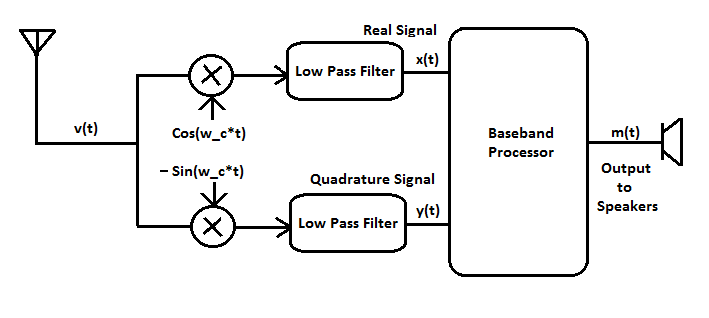Electronics Receiver: Difference between revisions
No edit summary |
No edit summary |
||
| (3 intermediate revisions by the same user not shown) | |||
| Line 3: | Line 3: | ||
When a Signal is transmitted they take the original baseband m(t) signal and send it through a bandpass processor that splits the signal into a real (x(t)) and an imaginary (y(t)) parts and then shifts the signal to +/- a designated frequency by mixing the signals with cos(w_c*t) for x(t) and -sin(w_c*t) for y(t). This is shown math mathematically below where v(t) is the output signal and w_c is the amount shifted. |
When a Signal is transmitted they take the original baseband m(t) signal and send it through a bandpass processor that splits the signal into a real (x(t)) and an imaginary (y(t)) parts and then shifts the signal to +/- a designated frequency by mixing the signals with cos(w_c*t) for x(t) and -sin(w_c*t) for y(t). This is shown math mathematically below where v(t) is the output signal and w_c is the amount shifted. |
||
<math> v(t) = Re[(x(t) + jy(t))*(cos(w_c*t)+jsin(w_c*t)) = Re[x(t)cos(w_c*t) + x(t)jsin(wc_t) + jy(t)cos(w_c*t) -y(t)sin(w_c*t) |
<math> v(t) = Re[(x(t) + jy(t))*(cos(w_c*t)+jsin(w_c*t)) = Re[x(t)cos(w_c*t) + x(t)jsin(wc_t) + jy(t)cos(w_c*t) -y(t)sin(w_c*t)</math> |
||
<br/> |
|||
= x(t)cos(w_c*t)-y(t)sin(w_c*t) </math> |
<math> = x(t)cos(w_c*t)-y(t)sin(w_c*t) </math> |
||
Latest revision as of 08:26, 5 April 2010
Electronics Receiver Explanation:
When a Signal is transmitted they take the original baseband m(t) signal and send it through a bandpass processor that splits the signal into a real (x(t)) and an imaginary (y(t)) parts and then shifts the signal to +/- a designated frequency by mixing the signals with cos(w_c*t) for x(t) and -sin(w_c*t) for y(t). This is shown math mathematically below where v(t) is the output signal and w_c is the amount shifted.
The purpose of your receiver is to retrieve this signal. This is done by first taking the transmitted signal and mixing it with cos(w_c*t)(to get x(t) and -sin(w_c*t) (to get y(t) also referred to as the quadrature signal) and filtering those two signals using a low pass filter. After you have those signals you can send them through a baseband processor (in the computer in this case) and it will process the signal and send the results to your speakers.



